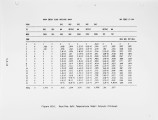| Title |
Modeling of Destruction Efficiency in a Pilot-Scale Combustor |
| Creator |
Wolbach, C. D.; Garman, A. R. |
| Publisher |
University of Utah |
| Date |
1984 |
| Spatial Coverage |
presented at Tulsa, Oklahoma |
| Abstract |
The combination of pressures from Resource Conservation and Recovery Act (RCRA) requirements and awareness of energy conservation needs have lead to increased interest in cofiring wastes in industrial boilers as a fuel supplement. The United States Environmental Protection Agency (EPA), in light of regulations on incinerators, began studies on the impact of cofiring and the ability of boilers to destroy wastes to 99.99 percent efficiency. During one phase of this work a simplistic model was formulated combining a boiler thermal history with global thermal destruction kinetics for given wastes in an effort to predict the ability of a particular boiler to destroy a specific waste to "four nines" efficiency. This was done to lessen the (potential) requirements for full-scale test burns that might arise from regulations. Although considerable efforts have gone into modeling of the chemistry that governs hazardous waste oxidation in idealized flow reactors, the physical and chemical processes which dominate destruction in real combustion devices have not been quantified. However, theoretical detail may not be necessary to accomplish the prediction of destruction and removal efficiency (DRE) to the accuracy required by most potential users. That is, such items as detailed kinetics, estimation of soot formation rates and radiosities may not need to be modeled in detail to predict DRE. It may be possible to model the destruction of wastes in a combustor on a small personal computer with sufficient accuracy to make engineering decisions. |
| Type |
Text |
| Format |
application/pdf |
| Language |
eng |
| Rights |
This material may be protected by copyright. Permission required for use in any form. For further information please contact the American Flame Research Committee. |
| Conversion Specifications |
Original scanned with Canon EOS-1Ds Mark II, 16.7 megapixel digital camera and saved as 400 ppi uncompressed TIFF, 16 bit depth. |
| Scanning Technician |
Cliodhna Davis |
| ARK |
ark:/87278/s6cn76ff |
| Setname |
uu_afrc |
| ID |
1952 |
| Reference URL |
https://collections.lib.utah.edu/ark:/87278/s6cn76ff |

































